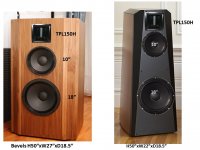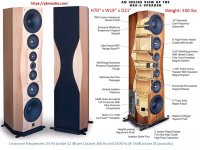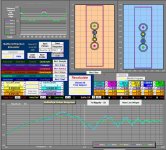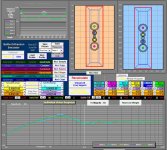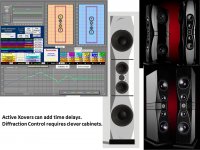Hi,
I just looked at my bank account and appararently I'm lacking a few hundred thousand dollars for the Göbels Majestic.. Oh well 🙂
[Edit - although nice the above speakers are not the design goal]
No, I have wanted to build some new hifi for a long time and I've been fiddling with this project for some months now. I would very much appreciate your input - steep learning curve. Probably stepping into various traps.
The project right now is to build a set of actively filtered 5-6 way front speakers for a living room about 4x6m. Mostly for music, secondary role as surround. I have an M&K X12 sub, but I would like the fronts to be able to carry most on their own. Surround speakers later on, when I have dialed in the fronts.
I guess you can discuss forever what "good sound quality" is, but you often ask what the person is trying to achieve. For me, it's about getting close to the way the studio intended the music. If that makes sense.
Target max SPL is "high enough for parties", while most of the time the listening level would be lower. Around 105-110 dB@1m minus some 6-12 dB at typical listening distance.
Max size is somewhere around 2m H x 1m D x 0,7m W. However I will do what I can to make it smaller/lighter to the eye, removing size/volume when possible.
Actually I had a whole other design in mind, but I would be very limited on volume. Right now WAF is not an issue, so I will keep that project as a backup 🙂
Input: from Marantz AV8805, XLR balanced (owned)
XO: 1x freeDSP-Aurora (a big thanks to Raphael et al) for each speaker, giving max 8 channels out (1 owned, 1 pending)
Amps: 3x ICEpower 1200AS2 for each speaker, giving 6 channels (owned)
Cabinets will likely end up being "hour-glass" like in form. Baltic birch 20-30 mm.
Drivers in a symmetric vertical alignment, angled towards listening position - SWWMTMWWS. Maybe a different arrangement for the subs, that is one thing I would like to ask about.
Current plan for drivers (not yet owned):
32W/4878T00
21WE/4542T00
18WE/4542T00
12MU/4731T00
GRT-145-4
12MU/4731T00
18WE/4542T00
21WE/4542T00
32W/4878T00
I have put some links in the bottom.
Other stuff:
Buying ARTA soon and need to learn a lot more on measurements.
Fiddling with Vituixcad (a big thanks to Kimmo).
Fiddling with Autocad. Challenge..
I read the "So you want to design your own speaker from scratch" (and loads of other stuff). I also have the "Loudspeaker Design Cookbook" that I'm reading on.
Questions/comments/stuff:
1 - The AV8805 might be a bottleneck at some point. I'll just have to cross that bridge when I get there.
2 - The freeDSP-Aurora seems pretty nice. Active xo will still be a lot of work, but I like the flexibility. I read about the Linkwits-Riley Transform. I don't think I can use it yet on the freeDSP-Aurora, but would be nice.
3 - I bought a case (7 units) of 1200AS2 for this project and maybe for some surround. I chose this particular ICEpower unit because it was the only one with the ICEedge chip. I know the power handling is overkill, but they had nothing smaller with that chip. Some day they will I guess, then I can replace. I also made a diy amp with one of the 1200AS2 boards. I'm no true expert in listening and measuring, but it's pretty nice. Much more detailed than my NAD M3. It has a bit of noise though which can be heard in a completely quiet room. Built it in if you can but beware of the heat monster.
4 - The limiting factor here will be the subs I believe. I chose to have two, one in bottom, one in top, closed cab, and I have tried to simulate to get an idea. If I do some low pass shelving, an active peak, a protective high pass in the bottom end, and then a low pass in the high end, I get something quite linear from 40-80 Hz @ 109,8 dB with an f3=24,8Hz. This is while staying within Xmax, IEC 17.1 etc. The phase is not so good probably. Tried to post a picture here:
5 - But.. can you even have a sub in the top of the speaker firing upwards? (and a sub in bottom firing down) Alternatively two in the bottom with access to that same volume from the top of the speaker maybe. I would kinda need that because I lack the front baffle space for a vertical alignment. Does the sub(s) have to be in the speaker at all? - no guess not, when those frequencies can't really be located anyway. It would be fun though 🙂
There is the ability to control the two subs independently you could say. 5 channels of amplification are needed for the 5 ways, but I could use the last 6'th channel to split up the subs if needed.
6 - Troels Gravesen uses BMS 12N630 in several designs and the SS T11. I looked at them but I think the 32W/4878T00 suits this better with its Xmax. I have simulated bass reflex and PR also, but I think I would prefer closed cab which should give better transient response as I understand.
7 - Other better matching driver choices maybe? I chose the Ellipticors because it seems on Troels that they are very musical and I have an indication from his projects that they will fit in, both with the tweeter and with the other SS units. Not saying they are the "best" and nothing can beat them.
Accuton maybe?.. I don't really know what to think of them.
And why not the SS Be dome when SS drivers for the rest, you might ask. I have had a wet dream about a ribbon like driver for a long time. Had it back in the days in a set of Prodipe monitors and it was fantastic. Originally I looked at the Mundorf AMT29CM, but eventually I found the Russian Tenors here with a more decent dispersion. Troels tried them with the 18WE/4542T00 and seemed happy. I have added the 12MU/4731T00 in between though, so still a bit interesting.
8 - XO and amps inside or outside the speaker? My understanding is that doing shielded line level most of the way is generally better (and also less cable) so that speaks for having the equipment close to or inside the speaker.
9 - Does it matter how good/bad a sound card I use for measurements? It seems to me the sound card output is often sent to the sound card as well to be retracted.
10 - For mitigating something like comb filtering I need to actually have the drivers and all their detailed off-axis measurements first, right? Else I would need to rely on extrapolated data and that would be guesswork?
11 - From experience I know that I need to add extra cooling for the 1200AS2 units. Alu plates on the outside probably. This will require some thermal testing though because I would like the amp itself to be inside (noise). They might have to be on the outside for airflow, in a cavity so it is in level with the cabinet surface. Then a big alu plate connected somehow. A resonance source to be thought about..
12 - If you know about some very good reading material on something like crossover design and measuring "stuff" I would like to hear from you as well. It's not so hard to find something, we're drowning in information. Finding the good stuff though..
Any other comments also much appreciated, thanks 🙂
/trip
https://www.scan-speak.dk/datasheet/pdf/32w-4878t00.pdf
https://www.scan-speak.dk/datasheet/pdf/32w-8878t11.pdf
https://www.scan-speak.dk/datasheet/pdf/21we-4542t00.pdf
https://www.scan-speak.dk/datasheet/pdf/18we-4542t00.pdf
https://www.scan-speak.dk/datasheet/pdf/12mu-4731t00.pdf
http://viawave.ru/files/GRT-145-4.pdf
https://icepower.dk/products/amplifier-power-modules/as-series-intelligent-audio-amplifier-power/
I just looked at my bank account and appararently I'm lacking a few hundred thousand dollars for the Göbels Majestic.. Oh well 🙂
[Edit - although nice the above speakers are not the design goal]
No, I have wanted to build some new hifi for a long time and I've been fiddling with this project for some months now. I would very much appreciate your input - steep learning curve. Probably stepping into various traps.
The project right now is to build a set of actively filtered 5-6 way front speakers for a living room about 4x6m. Mostly for music, secondary role as surround. I have an M&K X12 sub, but I would like the fronts to be able to carry most on their own. Surround speakers later on, when I have dialed in the fronts.
I guess you can discuss forever what "good sound quality" is, but you often ask what the person is trying to achieve. For me, it's about getting close to the way the studio intended the music. If that makes sense.
Target max SPL is "high enough for parties", while most of the time the listening level would be lower. Around 105-110 dB@1m minus some 6-12 dB at typical listening distance.
Max size is somewhere around 2m H x 1m D x 0,7m W. However I will do what I can to make it smaller/lighter to the eye, removing size/volume when possible.
Actually I had a whole other design in mind, but I would be very limited on volume. Right now WAF is not an issue, so I will keep that project as a backup 🙂
Input: from Marantz AV8805, XLR balanced (owned)
XO: 1x freeDSP-Aurora (a big thanks to Raphael et al) for each speaker, giving max 8 channels out (1 owned, 1 pending)
Amps: 3x ICEpower 1200AS2 for each speaker, giving 6 channels (owned)
Cabinets will likely end up being "hour-glass" like in form. Baltic birch 20-30 mm.
Drivers in a symmetric vertical alignment, angled towards listening position - SWWMTMWWS. Maybe a different arrangement for the subs, that is one thing I would like to ask about.
Current plan for drivers (not yet owned):
32W/4878T00
21WE/4542T00
18WE/4542T00
12MU/4731T00
GRT-145-4
12MU/4731T00
18WE/4542T00
21WE/4542T00
32W/4878T00
I have put some links in the bottom.
Other stuff:
Buying ARTA soon and need to learn a lot more on measurements.
Fiddling with Vituixcad (a big thanks to Kimmo).
Fiddling with Autocad. Challenge..
I read the "So you want to design your own speaker from scratch" (and loads of other stuff). I also have the "Loudspeaker Design Cookbook" that I'm reading on.
Questions/comments/stuff:
1 - The AV8805 might be a bottleneck at some point. I'll just have to cross that bridge when I get there.
2 - The freeDSP-Aurora seems pretty nice. Active xo will still be a lot of work, but I like the flexibility. I read about the Linkwits-Riley Transform. I don't think I can use it yet on the freeDSP-Aurora, but would be nice.
3 - I bought a case (7 units) of 1200AS2 for this project and maybe for some surround. I chose this particular ICEpower unit because it was the only one with the ICEedge chip. I know the power handling is overkill, but they had nothing smaller with that chip. Some day they will I guess, then I can replace. I also made a diy amp with one of the 1200AS2 boards. I'm no true expert in listening and measuring, but it's pretty nice. Much more detailed than my NAD M3. It has a bit of noise though which can be heard in a completely quiet room. Built it in if you can but beware of the heat monster.
4 - The limiting factor here will be the subs I believe. I chose to have two, one in bottom, one in top, closed cab, and I have tried to simulate to get an idea. If I do some low pass shelving, an active peak, a protective high pass in the bottom end, and then a low pass in the high end, I get something quite linear from 40-80 Hz @ 109,8 dB with an f3=24,8Hz. This is while staying within Xmax, IEC 17.1 etc. The phase is not so good probably. Tried to post a picture here:
An externally hosted image should be here but it was not working when we last tested it.
5 - But.. can you even have a sub in the top of the speaker firing upwards? (and a sub in bottom firing down) Alternatively two in the bottom with access to that same volume from the top of the speaker maybe. I would kinda need that because I lack the front baffle space for a vertical alignment. Does the sub(s) have to be in the speaker at all? - no guess not, when those frequencies can't really be located anyway. It would be fun though 🙂
There is the ability to control the two subs independently you could say. 5 channels of amplification are needed for the 5 ways, but I could use the last 6'th channel to split up the subs if needed.
6 - Troels Gravesen uses BMS 12N630 in several designs and the SS T11. I looked at them but I think the 32W/4878T00 suits this better with its Xmax. I have simulated bass reflex and PR also, but I think I would prefer closed cab which should give better transient response as I understand.
7 - Other better matching driver choices maybe? I chose the Ellipticors because it seems on Troels that they are very musical and I have an indication from his projects that they will fit in, both with the tweeter and with the other SS units. Not saying they are the "best" and nothing can beat them.
Accuton maybe?.. I don't really know what to think of them.
And why not the SS Be dome when SS drivers for the rest, you might ask. I have had a wet dream about a ribbon like driver for a long time. Had it back in the days in a set of Prodipe monitors and it was fantastic. Originally I looked at the Mundorf AMT29CM, but eventually I found the Russian Tenors here with a more decent dispersion. Troels tried them with the 18WE/4542T00 and seemed happy. I have added the 12MU/4731T00 in between though, so still a bit interesting.
8 - XO and amps inside or outside the speaker? My understanding is that doing shielded line level most of the way is generally better (and also less cable) so that speaks for having the equipment close to or inside the speaker.
9 - Does it matter how good/bad a sound card I use for measurements? It seems to me the sound card output is often sent to the sound card as well to be retracted.
10 - For mitigating something like comb filtering I need to actually have the drivers and all their detailed off-axis measurements first, right? Else I would need to rely on extrapolated data and that would be guesswork?
11 - From experience I know that I need to add extra cooling for the 1200AS2 units. Alu plates on the outside probably. This will require some thermal testing though because I would like the amp itself to be inside (noise). They might have to be on the outside for airflow, in a cavity so it is in level with the cabinet surface. Then a big alu plate connected somehow. A resonance source to be thought about..
12 - If you know about some very good reading material on something like crossover design and measuring "stuff" I would like to hear from you as well. It's not so hard to find something, we're drowning in information. Finding the good stuff though..
Any other comments also much appreciated, thanks 🙂
/trip
https://www.scan-speak.dk/datasheet/pdf/32w-4878t00.pdf
https://www.scan-speak.dk/datasheet/pdf/32w-8878t11.pdf
https://www.scan-speak.dk/datasheet/pdf/21we-4542t00.pdf
https://www.scan-speak.dk/datasheet/pdf/18we-4542t00.pdf
https://www.scan-speak.dk/datasheet/pdf/12mu-4731t00.pdf
http://viawave.ru/files/GRT-145-4.pdf
https://icepower.dk/products/amplifier-power-modules/as-series-intelligent-audio-amplifier-power/
Last edited:
Hi,
I just looked at my bank account and appararently I'm lacking a few hundred thousand dollars for the Göbels Majestic.. Oh well 🙂
To be fair, you're lacking a few tens of millions to build the room for the speakers. They advertise "fast bass" which means you need a drag strip to truly appreciate the lossless drivers. Unfortunately, they didn't supply the 0-60 times because their web site had to move on to finishing options.
Gonna be hard to get anything good with such a meager budget. I guess this should be ok for desktop use.
Considering your 4m x 5m size living room, to mimic the sound of the Göbels Majestic I would use three similarly constructed drivers in a T-M-W with crossovers around 1800Hz and 180Hz:
-Beyma TPL-150H pleated diaphragm tweeter with horn $450
-Faital 10PR320 10" midrange $350
-BMS 18N862 18" woofer 95db/watt $900
======
Göbels Majestic Drivers
2 pcs. Göbel® High End proprietary long-throw Bass chassis (18 inch)
2 pcs. Göbel® High End proprietary midrange chassis (8 inch)
1 pcs. significantly improved AMT tweeter with massive aluminum wave guide
-Beyma TPL-150H pleated diaphragm tweeter with horn $450
-Faital 10PR320 10" midrange $350
-BMS 18N862 18" woofer 95db/watt $900
======
Göbels Majestic Drivers
2 pcs. Göbel® High End proprietary long-throw Bass chassis (18 inch)
2 pcs. Göbel® High End proprietary midrange chassis (8 inch)
1 pcs. significantly improved AMT tweeter with massive aluminum wave guide
Attachments
Before you jump into the deep end why not try something simple first an get the feel of loudspeaker design. It is not a matter of throwing things together and hoping for the best, the 'Titanic' is an example of over exuberance gone wrong, and there are many examples of 'shipwrecks' in the loudspeaker learning curve.
C.M
C.M
@LineSource - Thank you, I'll take a look. While it was not the Majestic I was going for exactly, these do look interesting. Beyma with horn is not a thing I have looked much into before.
@Tweet - I agree, it's complex. I'll see what I can do to get some other experience first.
@Tweet - I agree, it's complex. I'll see what I can do to get some other experience first.
For first hand experience i will point you in to direction of a member at HTguide forum called Cochinada. He did something similar and if it weren't for laminating baltic birch it would be almost hassle free (not counting hassle taht you will have building those):
My first project is a 4 way speaker...
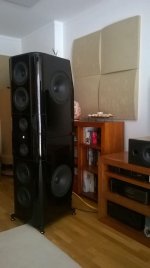
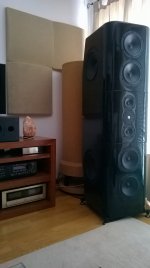
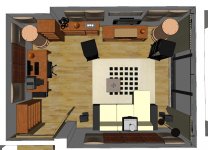
My first project is a 4 way speaker...



Last edited:
Before you jump into the deep end why not try something simple first an get the feel of loudspeaker design. It is not a matter of throwing things together and hoping for the best, the 'Titanic' is an example of over exuberance gone wrong, and there are many examples of 'shipwrecks' in the loudspeaker learning curve.
Er, speaking as a naval / maritime historian as my day job, I should in fairness point out that the Olympic class (of which Titanic was the second of the three) was actually quite a conservative design. They were large, but in engineering terms, straightforward; there wasn't any real over-exuberance in the hull or propulsion, and she stayed afloat longer than pretty much any other contemporary large liner was likely to have done after clouting that iceberg.
That said, agreed absolutely with the basic point: learn to walk before you try running.
Cool project! When you said hour glass shape I started thinking of lots of sheets of ply stepped to make the rough shape, hollow, then placed on a rotating platform and smoothed with a router. Lathe style. 3 piece.
I started my first project in 2017. Monster “4” way. Still working on it should be finished in 2021 a year late but so what... I’m in no hurry. One thing that surprised me was drivers I thought would work based on data did not. In the 100-300hz range I went thru a few until I got it. Plan on some flexibility and don’t marry yourself to drivers. My 2000$ two cents ... and give yourself lots of time. It’s a lot of fun and pain.🙂 it is the mother of all rabbit holes. “To go the ungodly distance” should be part of our motto. Why 5-6 way?
I started my first project in 2017. Monster “4” way. Still working on it should be finished in 2021 a year late but so what... I’m in no hurry. One thing that surprised me was drivers I thought would work based on data did not. In the 100-300hz range I went thru a few until I got it. Plan on some flexibility and don’t marry yourself to drivers. My 2000$ two cents ... and give yourself lots of time. It’s a lot of fun and pain.🙂 it is the mother of all rabbit holes. “To go the ungodly distance” should be part of our motto. Why 5-6 way?
@Zvu - Thank you for bringing that thread to my attention. Very nice reading. A shame with the first many pictures, but still very informative. Nice end product too.
Looked at translam before, but not sure. My initial plan was not doing it. Does it actually provide a basis for better sonic outcome or do people do it for other reasons?
I promise not to build my speakers in the shape of Titanic and steer them into an iceberg!
Although they would look kinda cool in baltic birch...
Looked at translam before, but not sure. My initial plan was not doing it. Does it actually provide a basis for better sonic outcome or do people do it for other reasons?
I promise not to build my speakers in the shape of Titanic and steer them into an iceberg!
Although they would look kinda cool in baltic birch...
Dump the low frequency woofer portion. You can't control the sound field of anything below your transition frequency. It will also substantially reduce the size of your enclosure.
@studiophone - Thanks for your 2 cents 🙂
Actually that's a pretty cool thought doing it stepped and hollowing it out. My thought was more edged, but when looking from the front you would have a narrow middle and wider top/bottom (like the Majestic for instance). I really need to draw it soon. I only have a drawing on the old project (which consisted only of triangles btw).
Well, 5 way was the idea because of all the projects I saw from Troels, mostly 4-way but also his 5-way Illuminator. Based on his designs/notes it seemed the 21WE and 18WE would work well together and the same concerning the 18WE and the GRT-145-4. He speaks very highly of the 12MU as well and mentions that it can do a few things that one of his favorite speakers (ATS-4-HE) can't. Disclaimer - all this is purely my understanding of his notes, not trying to say that it is in fact how Troels thinks.
So not in any way a proven design, but I had an idea that with the right amount of simulations, calculations, measurements and iterations of woodwork I could in the end get a very nice speaker with those units. But I get it.. drivers might surprise a lot.
Good luck with your own project studiophone 🙂
Looking at the Beyma TP-150 / TP-200. For some reason it has escaped my attention. The dispersion seems much lower than the GRT-145's. But okay, the dispersion might not matter to me so much when standing up at a party with a large drink and a small umbrella in my hair. The critical listening will be done sitting so 0-5 degree is the most important.
I read that the Beyma can benefit much from a super tweeter. That could be said about the GRT's as well I could imagine.
1x 18" could also be an idea instead of 2x 12". That could be driven to 1200W if I dedicate one of the 1200AS2's.
Ah well, now I'm already drifting into the unsubstantiated but beautiful driver rabbit hole again..
Actually that's a pretty cool thought doing it stepped and hollowing it out. My thought was more edged, but when looking from the front you would have a narrow middle and wider top/bottom (like the Majestic for instance). I really need to draw it soon. I only have a drawing on the old project (which consisted only of triangles btw).
Well, 5 way was the idea because of all the projects I saw from Troels, mostly 4-way but also his 5-way Illuminator. Based on his designs/notes it seemed the 21WE and 18WE would work well together and the same concerning the 18WE and the GRT-145-4. He speaks very highly of the 12MU as well and mentions that it can do a few things that one of his favorite speakers (ATS-4-HE) can't. Disclaimer - all this is purely my understanding of his notes, not trying to say that it is in fact how Troels thinks.
So not in any way a proven design, but I had an idea that with the right amount of simulations, calculations, measurements and iterations of woodwork I could in the end get a very nice speaker with those units. But I get it.. drivers might surprise a lot.
Good luck with your own project studiophone 🙂
Looking at the Beyma TP-150 / TP-200. For some reason it has escaped my attention. The dispersion seems much lower than the GRT-145's. But okay, the dispersion might not matter to me so much when standing up at a party with a large drink and a small umbrella in my hair. The critical listening will be done sitting so 0-5 degree is the most important.
I read that the Beyma can benefit much from a super tweeter. That could be said about the GRT's as well I could imagine.
1x 18" could also be an idea instead of 2x 12". That could be driven to 1200W if I dedicate one of the 1200AS2's.
Ah well, now I'm already drifting into the unsubstantiated but beautiful driver rabbit hole again..
@Zvu - Thank you for bringing that thread to my attention. Very nice reading. A shame with the first many pictures, but still very informative. Nice end product too.
Looked at translam before, but not sure. My initial plan was not doing it. Does it actually provide a basis for better sonic outcome or do people do it for other reasons?
I promise not to build my speakers in the shape of Titanic and steer them into an iceberg!
Although they would look kinda cool in baltic birch...
What would be cool is if someone would already use panzerholz for building material. For better sonic properties, of course:
The Virtues of Panzerholz : An Investigation into the Acoustical Properties of Aluminum and Panzerholz
Looking at the Beyma TP-150 / TP-200. For some reason it has escaped my attention.
Ah well, now I'm already drifting into the unsubstantiated but beautiful driver rabbit hole again..
You could......start a Paper Design around the TPL-150H
(1) you have a modest size 4m x 5m living room.
(2) Measurements show the TPL-150H reaches 20kHz, but like all horn loaded AMTs, the vertical polar response narrows at high frequencies, and this reduces nasty ceiling and floor effects, but also requires placement at ear level of 36" - 39" for smooth controlled directivity for both sitting and standing listeners.
(3) Consider a "vocal range" midbass with 80-100Hz to 1600-1700Hz coverage.
The ISO226 sensitivity graph shows that the 3.5KHz region is the most ear sensitive, and although 1.3K-1.7KHz is more sensitive to the ear than lower frequencies, there is a ear sensitivity plateau in the1.5K-1.7KHz region which makes it a good choice for midbass-to-tweeter Xovers. It is not possible to get a flat frequency response at the listener with a constant directivity speaker, so controlled directivity designs that narrow the polar response with increasing frequency are popular.
The $225 Faital 10PR320 is an excellent 95db/W "vocal range" midrange for your modest size room. Triple roll surround + low Le motor create an unusually smooth SPL wide bandwidth midrange. Sealed 0.9cuft volume has Qtc~0.5 with Fsc=89Hz. Leave a large open volume behind the driver for unobstructived pressure launch, behind which is a tapered rear volume with fiberglass absorption material.
A pair of $165 Dayton 12" RSS315HF-4 aluminum cone subwoofers in a side-side counter-force placement near the cabinet bottom for good floor gain has excellent reviews for both deep bass and sound quality. One Class-D amp per 4-ohm subwoofer.
=======
Tweek Geeks is the Colorado audio Boutique which developed the well reviewed BMF-1 speaker around the Beyma TPL150H AMT horn tweeter. The Faital 12FH530 is the midrange with a 1400Hz crossover, and two side-side counter-force Faital 12RS1066 woofers provide deep equalized bass. Extensive construction pictures are on the web. The BMF-1 stands 43”high x 16”wide x 20”deep, and this depth is needed for ~5cuft of volume for the two 12" woofers.
34 Best Tweek Geek's BMF Speaker in the making images in 2014 | Geek stuff, Geek things, Music speakers
======
Attachments
@LineSource - Thanks for the PBN inspiration. I see the beveled edge. I'm thinking how that affects the diffraction and what it helps for. Does the fluid depth difference of the bevel create a more evenly distributed spread of sound waves from diffraction (or how you say it)?
@bradleypnw - Thanks, I'll dive into the Schroeder frequency as well and try to take that into account.
@Zvu - Very nice material. New to me. Also pretty difficult to come by it seems. I guess it's about finding a guy with some B2B connections.
Although it would not be the material for my very first assembled box/prototype. I need to goof around with MDF and BB first a bit.
@LineSource - Thank you for that interesting proposal. I will study them closer and your specific suggestions. That controlled directivity thing is a topic I need to dive much deeper into. And wave guide theory.. And isobaric setups (if you can call it that)..
I also need to read more from the late Siegfried Linkwitz I can see. An inspiring man.
I could probably build the LX521.4 and get everything I ever asked for in terms of sound (including some subs). Visually though they are not so much my cup of tea, so I would rather try to see if I could incorporate some of the concepts into another build. But who knows, it seems my world of audio is being turned upside down often these days..
Actually it's my birthday today. That's one of those days where the trigger finger is extra itchy on the buy button. I will hold my horsy though. Learn more stuff. Simulate the crap out of something.
Take care
@bradleypnw - Thanks, I'll dive into the Schroeder frequency as well and try to take that into account.
@Zvu - Very nice material. New to me. Also pretty difficult to come by it seems. I guess it's about finding a guy with some B2B connections.
Although it would not be the material for my very first assembled box/prototype. I need to goof around with MDF and BB first a bit.
@LineSource - Thank you for that interesting proposal. I will study them closer and your specific suggestions. That controlled directivity thing is a topic I need to dive much deeper into. And wave guide theory.. And isobaric setups (if you can call it that)..
I also need to read more from the late Siegfried Linkwitz I can see. An inspiring man.
I could probably build the LX521.4 and get everything I ever asked for in terms of sound (including some subs). Visually though they are not so much my cup of tea, so I would rather try to see if I could incorporate some of the concepts into another build. But who knows, it seems my world of audio is being turned upside down often these days..
Actually it's my birthday today. That's one of those days where the trigger finger is extra itchy on the buy button. I will hold my horsy though. Learn more stuff. Simulate the crap out of something.
Take care
See what you can do about making a sensible loudspeaker solution, not some ugly 9 driver monster that will set you back 10,000 € for drivers only.
@LineSource - Thanks for the PBN inspiration. I see the beveled edge. I'm thinking how that affects the diffraction and what it helps for. Does the fluid depth difference of the bevel create a more evenly distributed spread of sound waves from diffraction (or how you say it)?
Attached baffle diffraction simulations.
1) 0.5" edge rounding/bevels
2) 4" edge rounding/bevels, similar to PBN MTM bevels
3) Designs with good solutions for baffle edge distortion
Attachments
What you describe is really a 4-way.
Lots of other comments, but the suggestion to walk before you run is spot on.
Start w a proven 1-way or 2-way.
Subs should be separate (so they can be done later), and given you want to use 2 per side and load them push-push. Even better get the next size driver down and make 4 subs. That might satisfy you (probably not, it is hard to just build one set of diy speakers).
By then you will know a lot more and make perhaps) better choices.
dave
Lots of other comments, but the suggestion to walk before you run is spot on.
Start w a proven 1-way or 2-way.
Subs should be separate (so they can be done later), and given you want to use 2 per side and load them push-push. Even better get the next size driver down and make 4 subs. That might satisfy you (probably not, it is hard to just build one set of diy speakers).
By then you will know a lot more and make perhaps) better choices.
dave
Cochinada was in trouble with his carpenter-made translam - the layers started to cracle open and the transparent piano lacquer had to be grinded off and the whole thing painted over.
I admit that there is some charm in these wmtmw towers. Some of the benefits get realized in a small room too. An enthusiast's choice!
But as said, not a recommended way to start a speaker building hobby! Learning to take measurements indoors, understand them, and to use VituixCAD and other simulators means lots of tests, protos and time.
Begin with a single 3-way speaker, dsp xo like minidsp 4x10HD or 2x4HD and two flea-market stereo amps or anything you have laying around. Don't get too excited to find the best drivers, it is more about how you use them!
I admit that there is some charm in these wmtmw towers. Some of the benefits get realized in a small room too. An enthusiast's choice!
But as said, not a recommended way to start a speaker building hobby! Learning to take measurements indoors, understand them, and to use VituixCAD and other simulators means lots of tests, protos and time.
Begin with a single 3-way speaker, dsp xo like minidsp 4x10HD or 2x4HD and two flea-market stereo amps or anything you have laying around. Don't get too excited to find the best drivers, it is more about how you use them!
- Status
- Not open for further replies.
- Home
- Loudspeakers
- Multi-Way
- Front speakers - Project Mothership
